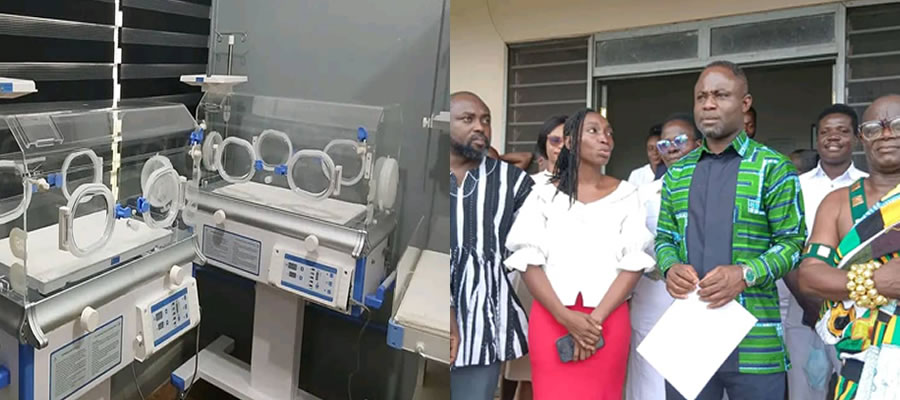

Bathing and Toilet Facilities
Toilet facilities
Figure 8.1 and Table 8.11 show the toilet facilities available in the district for household use. The highest proportion of the households use pit latrine (61.1%), followed by public toilet (23.0%), KVIP (3.9%) and WC (2.5%). The proportion of households with no toilet facility (bush/beach/field) is 7.2 percent.
In rural locality, higher proportions of households use pit latrine (61.8%) and have no toilet facility (7.6%) than the proportions among urban household (54.4% and 3.7%, respectively). In urban locality, higher proportions among the households use public toilet (28.6%), WC (7.3%) and KVIP (4.8%) than the proportions among rural households (22.4%, 2.0% and 3.8%, respectively).
Bathing facilities
Table 8.11 shows the bathing facilities available to households in the district. The highest proportion of households have own bathroom for exclusive use (38.0%), followed by shared separate bathroom in the same house (26.1%), shared open cubicle (11.6%), bathroom in another house (7.9%) and open space around house (7.3%).
In rural locality, higher proportions of households have own bathrooms for exclusive use (40.3%), private open cubicle (9.5%), use bathroom in another house (8.6%) and open space around house (7.7%) than the proportions among urban households (16.8%, 1.9%, 2.1% and 3.4%, respectively). Among urban households, higher proportions use shared separate bathrooms in the same house (61.9%) and shared open cubicle (13.7%) than their counterparts in rural locality (22.1% and 11.4%, respectively).
Waste Disposal
Solid waste disposal
Table 8.12 shows the methods that households in the district use to dispose of solid waste by locality. About 60.1 percent of households dispose of solid waste at public dump (open space), 18.6 percent dump solid waste indiscriminately, 12.6 percent dispose of solid waste at public dump (container), 4.1 percent burn the solid waste, 2.8 percent have the solid waste collected and 1.4 percent bury the solid waste.
In urban locality, a higher proportion of households (57.6%) use the public dump (container) compared to 7.6 percent of rural households. Also a higher proportion of urban households (4.1%) bury solid waste compare to 1.1 percent of rural households. Higher proportions of rural households use the other methods than their urban counterparts, 63.4 percent of the rural households dispose of solid waste at public dump (open space) compared to 30.7 percent of urban households; 20.3 percent of rural households dump solid waste indiscriminately compared to 3.4 percent of urban households; 4.3 percent of rural households dispose of solid waste by burning compare to 2.3 percent of urban households and 3.0 percent of rural households have the solid waste collected compare to 1.5 percent of urban households.
Liquid Waste Disposal
Table 8.12 shows the methods of liquid wastes disposal by households in the district by locality. Majority of households (55.3%) throw liquid waste on to compound; 25.8 percent throw liquid waste onto streets/outside, 10.5 percent throw liquid waste into gutter and 4.7 percent dispose of liquid waste through sewerage system.
Two liquid waste disposal methods that are widely used by rural households namely: throw onto compound (58.1%) and throw onto street/outside (26.5%). Three methods that dominate in liquid waste disposal in urban households are, throw into gutters (41.0%), throw onto compound (29.9%) and throw onto street/outside (19.8%). Higher proportions of urban households throw liquid waste into gutter (41.0%) and through drainage system into gutter (8.0%) than the proportions of rural households (7.1% and 2.1%, respectively). Higher proportions of rural households throw liquid waste onto compound (58.1%), throw onto street/outside (26.5%) and through the sewerage system (5.1%) than the proportions of urban households (29.9%, 19.8% and 0.5%, respectively).
Date Created : 11/20/2017 6:33:45 AM











 facebook
facebook
 twitter
twitter
 Youtube
Youtube
 +233 593 831 280
+233 593 831 280 0800 430 430
0800 430 430 GPS: GE-231-4383
GPS: GE-231-4383 info@ghanadistricts.com
info@ghanadistricts.com Box GP1044, Accra, Ghana
Box GP1044, Accra, Ghana